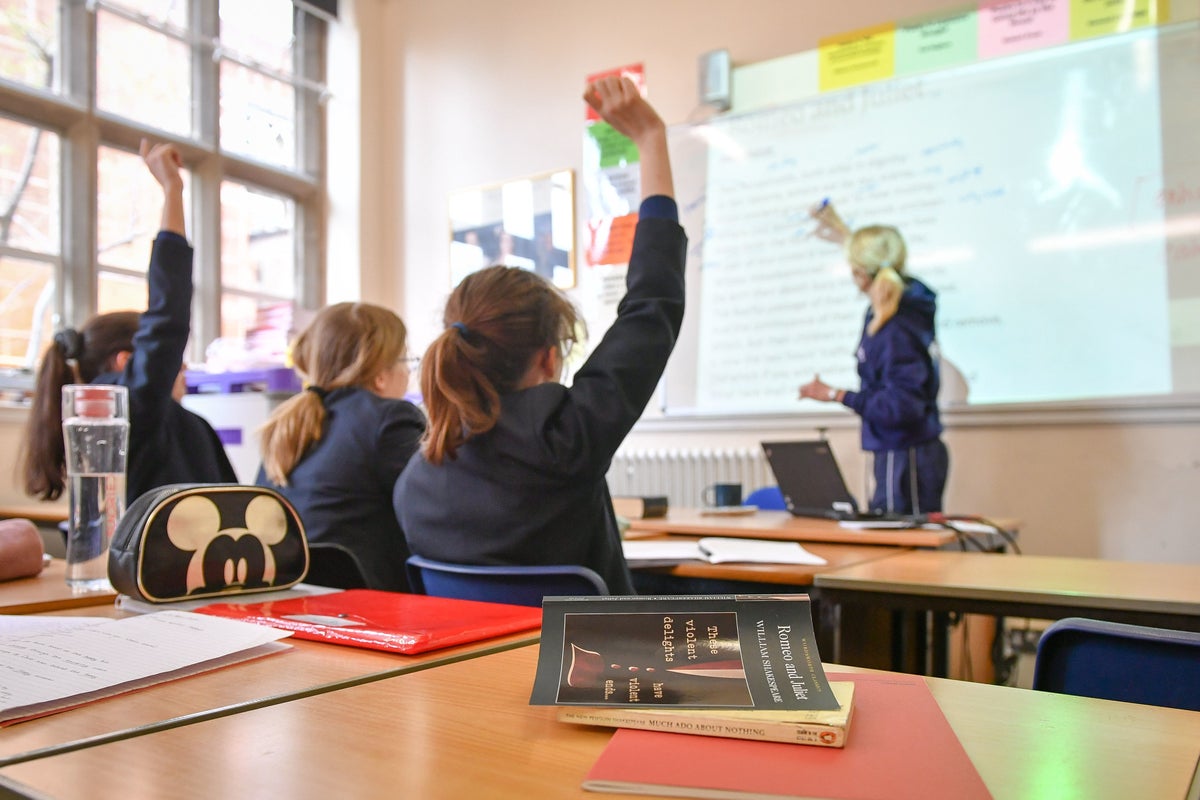
More than 100 schools in England have been told to immediately close classrooms and buildings over safety fears, plunging the annual back to school rush into chaos for many.
Thousands of pupils now risk having to start the year taking lessons online or in temporary accommodation.
Ministers were accused of “incompetence” after the order – which will see some schools forced to shut completely – was issued just days before schools reopen next week after the summer break.
The number of schools affected could still rise as newly issued government guidance set out plans to survey all schools suspected of suffering similar problems within “weeks”.
Teaching unions slammed the situation as “nothing short of a scandal”.
The closures follow fears over a type of concrete, described as “80 per cent air” and “like an Aero Bar”.
Known as reinforced autoclaved aerated concrete (RAAC), the lightweight material was used in schools, colleges and other buildings between the 1950s and the mid 1990s, but has since been found to be at risk of collapse.
Earlier this year the National Audit Office (NAO) assessed the risk of injury or death from the collapse of a school building as “very likely and critical.”
Is your school affected by the closures? Email us at newsdesk@independent.co.uk
Some schools will need to ‘either fully or partially relocate’ to alternative accommodation while safety measures are installed— (PA)
Schools have been told they can temporarily house pupils in local community centres or empty office buildings.
But the government’s guidance to schools said funding will only be provided for works that are “capital funded” and schools will have to pay for rental costs themselves for emergency or temporary accommodation.
Education secretary Gillian Keegan said telling schools to vacate areas containing the concrete was “the right thing to do for both pupils and staff” as she insisted the plans would “minimise” the impact on pupils.
“Nothing is more important than making sure children and staff are safe in schools and colleges, which is why we are acting on new evidence about RAAC now, ahead of the start of term,” she said.
Over the summer engineers have been assessing school sites for RAAC and “a couple of cases have given us cause for concern.” she told the BBC.
But the Children’s Commissioner called for “clear direction” about where pupils should go.
Dame Rachel de Souza warned ministers had to learn “lessons from the pandemic”.
“After years of disruption for children and young people, what they need most is stability and getting back to normal”, she said.
“Everything must now be done to ensure the impact on children’s learning is minimised. And it is particularly important that everyone working with children prioritises those who are vulnerable and those with additional needs.”
The Department for Education said it was taking precautionary steps following “careful analysis of new cases”.
In June Matt Byatt of the Institution of Structural Engineers told BBC Radio 4 that the material was “not really concrete as we know it. Normal reinforced concrete is good and solid and can last hundreds of years and can be compared to a Yorkie bar whereas (this) is more like an Aero. It’s 80 per cent air.”
Union Unison labelled the situation “nothing short of a scandal”, saying the “eleventh hour” decision would create “turmoil.”
“The DfE and government have squandered valuable months hiding this crisis when they should have been fixing dangerous school buildings”, Mike Short from Unison said.
“The schools minister even broke his own promise to publish information about at-risk properties before parliament’s summer recess.
“To wait until the eleventh hour as schools are preparing for a new academic year will create turmoil for thousands of families. And this could just be the tip of the iceberg.”
A government official described the atmosphere at the Department for Education as "busy and stressful", adding: "The DfE are working tirelessly to rectify the situation."
Paul Whiteman, the general secretary of school leaders’ union NAHT, described the news as “shocking”, but “not hugely surprising.”
“What we are seeing here are the very real consequences of a decade of swingeing cuts to spending on school buildings,” Mr Whiteman said.
“The government is right to put the safety of pupils and staff first – if the safety of buildings cannot be guaranteed, there is no choice but to close them so urgent building work can take place.
“But there is no escaping the fact that the timing of this couldn’t be worse, with children due to return from the summer holidays next week.”
Elsewhere, Association of School and College Leaders policy director Julie McCulloch accused the government of being too slow to respond.
“The danger of structural failure in school buildings where this type of concrete was used in construction has been known since at least 2018”, Ms McCulloch said.
Shadow education secretary Bridget Phillipson accused ministers of an "absolutely staggering display of Tory incompetence" and called on Ms Keegan to get a “grip” on her department.”
Liberal Democrat education spokeswoman Munira Wilson said: “Parents, teachers and pupils will be horrified that children have been taught in unsafe buildings and cannot return to school next week.”
North of the border, where education is devolved to the Scottish Government, the Scottish Liberal Democrats alleged that 37 schools contain the concrete.







